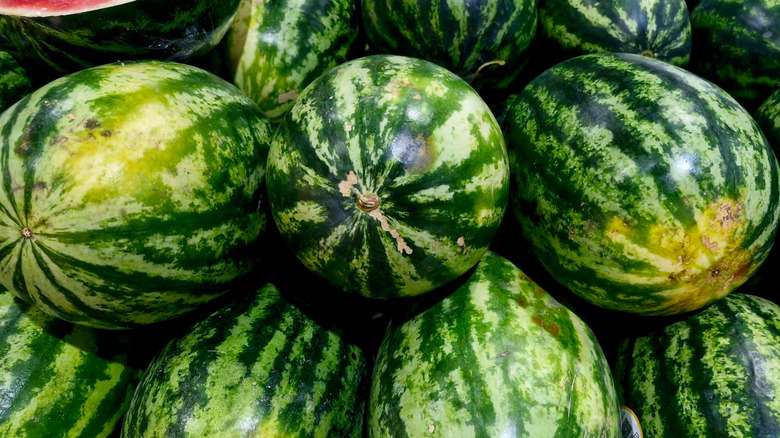The Foolproof Watermelon Tip For Picking The Sweetest One At The Store
Picking the freshest perishable groceries requires a bit of know-how, from knowing the best times to hit the store to when produce is in season. When it comes to watermelon, you can slap, sniff, and feel the fruit all you want, but one simple trick all but guarantees you'll pick the sweetest one in the bunch.
When picking out a watermelon, place your first two fingers against the rind. If both fingers fit within a single stripe, then you have yourself a sweet one. Fortunately, this trick doesn't correspond to the size of the watermelon itself, so feel free to apply it to fruit of any size. The color of the stripes themselves should also be quite dull. Watermelons darken as they ripen, so a bright color may indicate it needs more time to achieve the perfect flavor. While watermelon varieties vary in color and pattern, from the almost black sugar baby to the bright yellow golden midget, you shouldn't ever pick the brightest one in the bunch.
One other thing to look for are little scabs that look almost like webbing. These scars indicate that the flower from which the melon grew was pollinated by many bees, which in turn means it will be sweet.
Other watermelon testing tricks
While most places won't let you cut open and sample a melon on the spot, watermelon is one of the easiest fruits to judge simply based on appearances. Most of the time, just picking one up, feeling the rind, and judging its color and pattern are enough to answer all your watermelon questions.
The field spot, that pale colorless patch where the watermelon lay directly on the ground, is a great indicator of how long the fruit was left to ripen on the vine. If it were pulled prematurely, the spot would be white. If it had the right amount of time, that spot should be a buttery yellow similar to a banana. You can also check the tendril of the vine on one end to see how long the watermelon was allowed to sit on the vine. Green tendrils indicate it wasn't ripe when harvested, but a brown, dried-up twig means it was taken out of the field once it was fully ready.
If your choices are of a similar size, always opt for the heavier one. This means it's holding more water, so it'll be much juicier. This also plays into one of the most famous watermelon evaluation methods – the thump test. Ripe watermelons sound hollow because more of their interior is juice rather than flesh. However, if it makes a dull sound, it may be too far gone.


